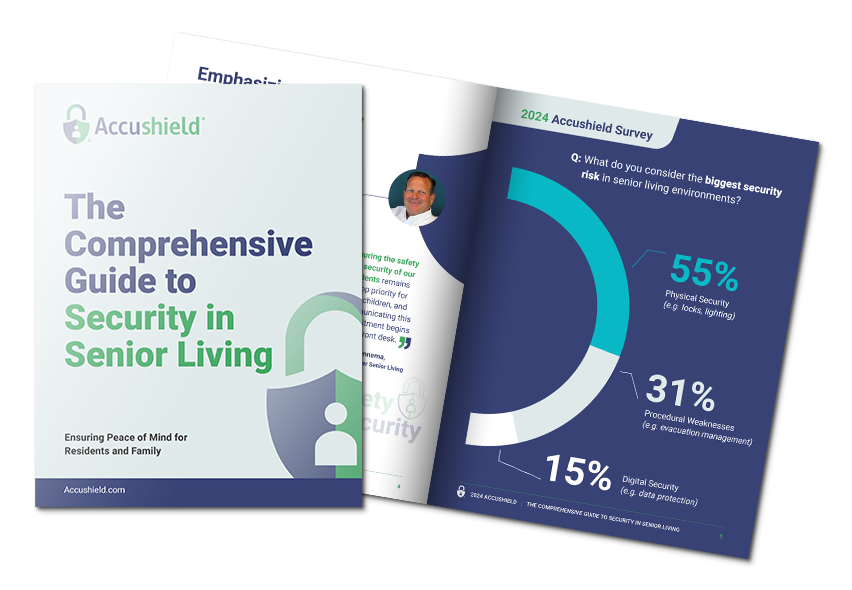From personal belongings to community property, theft in senior living can have serious financial, emotional, and reputational consequences. This guide outlines nine proven theft prevention strategies to help senior living operators strengthen safety, visibility, and trust.
Why Theft Prevention Matters
In senior living, people come and go constantly — from residents, family members, third-party caregivers, and vendors. With so much daily activity, maintaining complete visibility into who enters and what happens inside the building is absolutely essential.
Theft prevention in senior living goes far beyond protecting valuables; it’s about preserving trust, security, and peace of mind for everyone. Families choose a community with the expectation of safety, dignity, and care for their loved ones. When a theft or incident occurs, even if its minor, it can shatter that sense of trust and comfort.
Proactive theft prevention demonstrates that a community values transparency and accountability every single day. Technology-driven solutions, like visitor management systems and digital sign-in tracking, helps ensure that everyone entering the building is identified and authorized. These safeguards not only deter theft but also reinforce a culture of professionalism and integrity.
9 Proven Theft Prevention Strategies
Theft prevention is community-wide effort.
Here are nine essential strategies to reduce theft in senior living:
1. Optimize Interior and Exterior Lighting
Lighting is one of the most effective and affordable tools in deterring theft. A well-lit environment naturally discourages suspicious activities by increasing visibility and reducing hiding spots. Consistent, intentional lighting design throughout entrances, hallways, parking areas, and outdoor walkways enhances safety and comfort for everyone.
2. Maintain Clear, Low Landscaping
Clear, low landscaping helps improve visibility, making it easier to monitor activity and identify suspicious behavior. By maintaining and designing landscaping with safety in mind, communities can enhance both aesthetics and security simultaneously.
3. Install and Manage Security Cameras
Strategically placed cameras in entryways, hallways, and common areas deter unauthorized activity and promote accountability. Regular monitoring and proper data management also provide documentation in case of incidents.
4. Use Locks and Alarm Systems
Investing in locks and modern alarm systems shows your community takes security seriously. It is important to secure sensitive areas—like medication rooms, supply closets, and staff-only zones—with access controls. Alarm systems add another layer of protection.
5. Implement Inventory Management Protocols
Regularly tracking community assets—such as supplies, equipment, and personal items—helps supports a culture of accountability. Clear inventory procedures also make it easier to investigate missing items quickly and maintain accurate documentation.
6. Provide Secure Storage for Valuables
Providing secure storage options like lockable drawers, safes, or personal lockers for both residents and staff demonstrates respect and trust. Even a small investment in secure storage can significantly improve peace of mind and satisfaction.
7. Strengthen Medication Management Controls
Implementing strict controls for storage, access, and documentation is essential for both theft prevention and regulatory compliance. A strong medication management protocol safeguards resident health, ensures compliance, and protects integrity.
8. Monitor Community Entry and Exit
Visibility into who enters and leaves the building is essential. A digital visitor management system helps track every entry and exit in real time all while enhancing emergency preparedness and community connection.
9. Implement the Buddy System
When staff work in pairs, especially during after-hours shifts or inventory handling, there are fewer opportunities for theft and greater mutual oversight. This approach fosters teamwork, builds trust, and reinforces a shared responsibility to community safety.
Building a Culture of Safety & Accountability
Technology and tools are only as effective as the people and processes behind them. Clear, consistently enforced protocols create a foundational culture of safety and accountability.
Here are a few best practices:
- Communicate and Train – Integrate security expectations and protocols into onboarding and ongoing staff training. Reinforce these standards regularly.
- Document Procedures – Keep all procedures like visitor management, incident reporting, and medication handling accessible in digital or printed manuals.
- Lead by Example – Recognize staff who uphold community standards and ensure that all leadership supports and follows these expectations as well.
When everyone is aligned, the community is far better equipped to prevent theft, respond to incidents quickly, and maintain a safe, trusted environment for everyone.
Protecting What Matters Most
Effective theft prevention in senior living is all about fostering trust, transparency, and peace of mind. By implementing these nine strategies, communities can protect residents, improve reputation, and create a safer, more connected environment for everyone who walks through the door.
